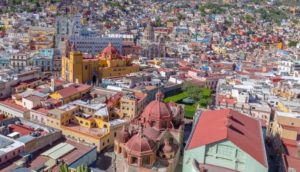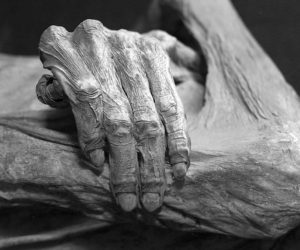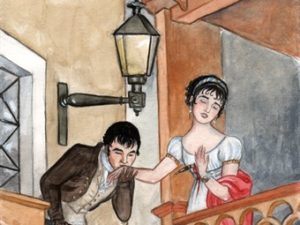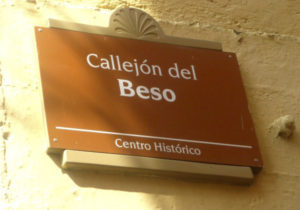Podcast: Play in new window | Download
Subscribe: Apple Podcasts | RSS
 The great state of Guanajuato is located in the northern part of central Mexico and borders 5 other states: Jalisco to the west, Zacatecas to the northwest, San Luis Potosí to the north, Querétaro to the east, and Michoacán to the south. In pre-Hispanic times the area was home to several indigenous groups. In addition to many nomadic tribes collectively called the Chichimeca by both the Aztecs and the Spanish, Guanajuato was also home to the complex civilization of the Chupícuaro which flourished from about 800 BC to 300 AD. The area was never conquered by the Aztecs although they did have influence there, as did the Purépecha kingdoms to the southeast. The Spanish arrived in the 1520s, soon after the fall of the Aztec capital of Tenochtitlán, in search of gold and other minerals. In 1548 the town of Guanajuato was established which today serves as the capital of the modern Mexican state of Guanajuato. The city and state are steeped in history and legends. Here are five.
The great state of Guanajuato is located in the northern part of central Mexico and borders 5 other states: Jalisco to the west, Zacatecas to the northwest, San Luis Potosí to the north, Querétaro to the east, and Michoacán to the south. In pre-Hispanic times the area was home to several indigenous groups. In addition to many nomadic tribes collectively called the Chichimeca by both the Aztecs and the Spanish, Guanajuato was also home to the complex civilization of the Chupícuaro which flourished from about 800 BC to 300 AD. The area was never conquered by the Aztecs although they did have influence there, as did the Purépecha kingdoms to the southeast. The Spanish arrived in the 1520s, soon after the fall of the Aztec capital of Tenochtitlán, in search of gold and other minerals. In 1548 the town of Guanajuato was established which today serves as the capital of the modern Mexican state of Guanajuato. The city and state are steeped in history and legends. Here are five.
Number One: The Legend of the Princess of Bufa.
It is said that in the Sierra de la Bufa there exists an enchanted princess of great beauty. She is part phantom and part supernatural creature and her greatest wish is to become fully human. Every Thursday she stops travelers on their way to the city of Guanajuato and asks to be taken to the Basilica of Guanajuato. She claims she wants to pray at the main altar there and only in that church can the enchanted princess break the spell cast on her years ago to become a complete human woman and only on certain conditions. The young man who can help her break the spell will be rewarded with riches beyond his wildest dreams but he must have the strength of will to withstand several tests. The biggest test occurs when the enchanted princess and the young man enter the city of Guanajuato. Upon entering the city he must carry her all the way to the basilica. While the princess is being carried, the man will hear voices and strange noises all around him that he must ignore. If he carries her in his arms, walks around without embarrassment and without turning his face all the way to the basilica’s altar, he will receive the riches and the enchanted princess will turn into a woman. If the chosen one loses his composure and turns backwards or reacts to the voices or noises in any way, then the beautiful girl becomes a horrible serpent and everything ends there. For four centuries this story has been told, and so far there has not been anyone who meets the requirements to undo the spell.
Legend Number Two: The Living Mummy
The city of Guanajuato is home to the Mummy Museum which houses a collection of mineralized remains of common people disinterred from local cemeteries throughout the 19th Century and into the early 20th Century. For more details about the Mummies of Guanajuato in fact and fiction, please visit Mexico Unexplained episode number 15.
 This legend tells the story of a man visiting the city of Guanajuato from out of town, on a business trip there for a conference. On the first day of the conference, all the attendees left early because the last speaker did not show up. Because he had extra time on his hands, the out-of-towner decided to visit the mummy museum. As it was a slow day at the museum that afternoon, the visitor chatted up the ticket taker. The ticket taker told the man that he was lucky because 36 of the mummies had just come back from touring the United States for 4 years, so now the exhibition at the museum was complete again. The man toured the museum and noticed that one of the mummies was missing; there was a space in the exhibit where he thought one of them should have been but wasn’t. He didn’t think much of it and left the museum for his hotel which was in walking distance. A few streets away from his hotel he witnessed a car run over a woman just feet in front of him. He ran to assist the woman. She was wearing a silk scarf over her head that covered her face and her clothing looked old. When she grabbed the man’s hand chills came over him as he noticed that her hand looked like those seen on the mummies in the museum.
This legend tells the story of a man visiting the city of Guanajuato from out of town, on a business trip there for a conference. On the first day of the conference, all the attendees left early because the last speaker did not show up. Because he had extra time on his hands, the out-of-towner decided to visit the mummy museum. As it was a slow day at the museum that afternoon, the visitor chatted up the ticket taker. The ticket taker told the man that he was lucky because 36 of the mummies had just come back from touring the United States for 4 years, so now the exhibition at the museum was complete again. The man toured the museum and noticed that one of the mummies was missing; there was a space in the exhibit where he thought one of them should have been but wasn’t. He didn’t think much of it and left the museum for his hotel which was in walking distance. A few streets away from his hotel he witnessed a car run over a woman just feet in front of him. He ran to assist the woman. She was wearing a silk scarf over her head that covered her face and her clothing looked old. When she grabbed the man’s hand chills came over him as he noticed that her hand looked like those seen on the mummies in the museum.
“Welcome to Guanajuato,” she said, “And thank you.”
He shook his head and closed his eyes to clear his senses, and in an instant, she was gone. The man realized that he had an encounter with a living mummy that had escaped the museum.
Number Three: The Legends of Santa Cecilia Castle
Located in an older part of the city of Guanajuato is a hotel called the Castillo Santa Cecilia which has seen many guests over the years, some of whom apparently have never left, according to the many legends surrounding this place. Guests have reported doors and windows opening and closing under their own power as well as strange noises and voices. Some have said that they have a sense of heaviness when they walk inside the hotel and others have felt a bone-chilling cold or unexplained bursts of wind in their rooms. Some guests have claimed to have been touched by invisible presences or have seen translucent figures out of the corners of their eyes. There are two stories of note connected with the hotel worth mentioning here. One, involves the apparition of a little girl of about 10 years old. She is very pale-faced and has dark eyes and is dressed in colonial Spanish dress. She has been seen standing in the hallways on several occasions and stares down guests. The other apparition involves a woman. A woman from the minor nobility of Europe – a countess or a baroness – was supposedly killed in room 403. Her ghost haunts the halls of the hotel. So far no ghost-hunting shows have visited the Santa Cecilia Hotel, but it sure would make a great place to take an EMF meter or other ghost-hunting equipment.
The last two legends have to do with a very famous landmark in the city of Guanajuato, the Callejón del Beso, which loosely translates in English to “Alley of the Kiss” in the colonial heart of the city, where cobblestoned streets are lined with 17th Century buildings. The alleyway is so named because the buildings facing the alley are so close that people can kiss each other from the balconies of opposite buildings. Both legends from the callejón date back to the Spanish 18th Century.
 In the first legend we find a wealthy family from Spain who had just moved to Mexico and acquired a building that had a balcony facing the famous alleyway. The daughter of the couple named Ana was a beautiful young woman who loved to sit on the balcony at night and look up at the stars. One night Ana noticed a young man who was renting a room in the building across the alley from her parent’s home. He was Carlos, a miner, who barely had enough money to rent that room. As soon as he stepped out on to his balcony and saw Ana, it was love at first sight. Because of the narrowness of the alley, they could literally touch each other just by stretching their arms a little. That gave them the idea of being able to kiss without the girl’s father discovering them. Ana and Carlos knew that Ana’s father would not approve of their relationship because of the disparity in social class and wealth. In fact, Ana’s father would not even let his precious daughter talk to the likes of a lowly miner. Their plan did not work and Ana’s father did catch the two kissing on their respective balconies over the alley. He reacted with rage towards his daughter and threatened to kill her if she would ever bring such disgrace to the family ever again. He told Ana that he would rather see her dead than have the family shamed. Ana did not believe the threat because she was an only child and she did not think that her father would actually carry through with his threats. So, the next day, she met the miner on the balcony and kissed him. Ana’s father saw it all. That night, while Ana was asleep, her father entered her bedroom and stabbed her to death. Unable to do anything, Carlos left Guanajuato never to return again. The legend doesn’t end there. In the city, to this day, on the spot where this story supposedly occurred, in the narrowest part of the alley, visitors are supposed to kiss each other on the third step which is clearly marked in red. The reward is 15 years of happiness and prosperity. If you do not do this, you run the risk of suffering seven years of bad luck, just as if you had broken a mirror. For those who walk alone, the curse does not apply.
In the first legend we find a wealthy family from Spain who had just moved to Mexico and acquired a building that had a balcony facing the famous alleyway. The daughter of the couple named Ana was a beautiful young woman who loved to sit on the balcony at night and look up at the stars. One night Ana noticed a young man who was renting a room in the building across the alley from her parent’s home. He was Carlos, a miner, who barely had enough money to rent that room. As soon as he stepped out on to his balcony and saw Ana, it was love at first sight. Because of the narrowness of the alley, they could literally touch each other just by stretching their arms a little. That gave them the idea of being able to kiss without the girl’s father discovering them. Ana and Carlos knew that Ana’s father would not approve of their relationship because of the disparity in social class and wealth. In fact, Ana’s father would not even let his precious daughter talk to the likes of a lowly miner. Their plan did not work and Ana’s father did catch the two kissing on their respective balconies over the alley. He reacted with rage towards his daughter and threatened to kill her if she would ever bring such disgrace to the family ever again. He told Ana that he would rather see her dead than have the family shamed. Ana did not believe the threat because she was an only child and she did not think that her father would actually carry through with his threats. So, the next day, she met the miner on the balcony and kissed him. Ana’s father saw it all. That night, while Ana was asleep, her father entered her bedroom and stabbed her to death. Unable to do anything, Carlos left Guanajuato never to return again. The legend doesn’t end there. In the city, to this day, on the spot where this story supposedly occurred, in the narrowest part of the alley, visitors are supposed to kiss each other on the third step which is clearly marked in red. The reward is 15 years of happiness and prosperity. If you do not do this, you run the risk of suffering seven years of bad luck, just as if you had broken a mirror. For those who walk alone, the curse does not apply.
 The other legend of the Callejón del Beso is a variation on the first story. Outside the city of Guanajuato there lived a wealthy family in a large hacienda. The couple had one daughter, a young woman named Carmen who was very beautiful and who was spoiled by her parents, even though she did not have a very good relationship with her father. One day at dinner Carmen’s father announced that Carmen would be married to a very wealthy man from Spain who was 40 years older than she was, an ugly man known for treating people cruelly. Carmen cried for many days and nights after hearing the news of her fate. One of Carmen’s only friends, a young woman named Brigida, felt for her friend and thought the best way to cheer her up was to introduce Carmen to new people. Brigida had a home in the city, on the Callejón del Beso. While visiting Brigida’s house, Carmen noticed a young man in the building across the alley. She went out to the balcony to try to catch his eye and then he, too, went out on his balcony to meet her. The man’s name was Don Luis. He was tall and handsome, with curly dark hair and light blue eyes, and very well educated and polite. They were instantly in love. Thanks to Brigida, Carmen and Luis would have several romantic meetings across the alley, that was, until word of what was going on reached Carmen’s father back at the hacienda. One day, he followed Carmen to Brigida’s house and when Carmen and Luis were locked in an embrace across the alley, he lunged at her and stabbed her, and then stormed out of the house. In her final moments of life, Don Luis held Carmen’s pale hand and gave her a final kiss goodbye. The ghost of the handsome, blue-eyed Don Luis is said to be walking the alleyways looking for Carmen to this day and has even been spotted by tourists.
The other legend of the Callejón del Beso is a variation on the first story. Outside the city of Guanajuato there lived a wealthy family in a large hacienda. The couple had one daughter, a young woman named Carmen who was very beautiful and who was spoiled by her parents, even though she did not have a very good relationship with her father. One day at dinner Carmen’s father announced that Carmen would be married to a very wealthy man from Spain who was 40 years older than she was, an ugly man known for treating people cruelly. Carmen cried for many days and nights after hearing the news of her fate. One of Carmen’s only friends, a young woman named Brigida, felt for her friend and thought the best way to cheer her up was to introduce Carmen to new people. Brigida had a home in the city, on the Callejón del Beso. While visiting Brigida’s house, Carmen noticed a young man in the building across the alley. She went out to the balcony to try to catch his eye and then he, too, went out on his balcony to meet her. The man’s name was Don Luis. He was tall and handsome, with curly dark hair and light blue eyes, and very well educated and polite. They were instantly in love. Thanks to Brigida, Carmen and Luis would have several romantic meetings across the alley, that was, until word of what was going on reached Carmen’s father back at the hacienda. One day, he followed Carmen to Brigida’s house and when Carmen and Luis were locked in an embrace across the alley, he lunged at her and stabbed her, and then stormed out of the house. In her final moments of life, Don Luis held Carmen’s pale hand and gave her a final kiss goodbye. The ghost of the handsome, blue-eyed Don Luis is said to be walking the alleyways looking for Carmen to this day and has even been spotted by tourists.
REFERENCES
Taken from the web site leyendasdelterror.com (in Spanish)
